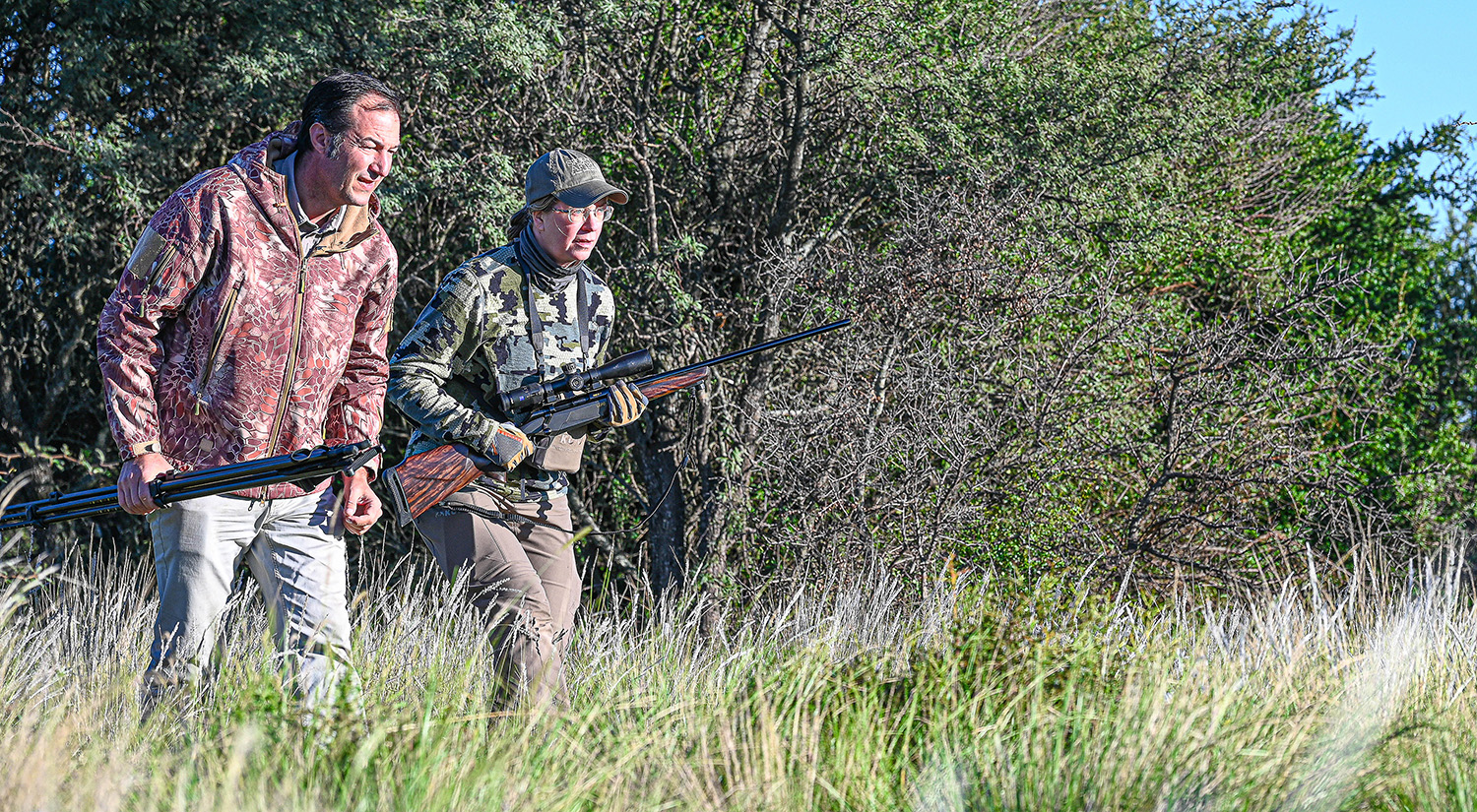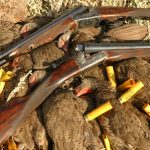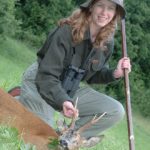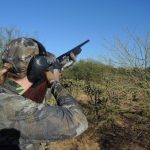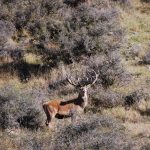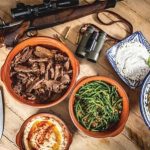A combo hunt for birds and big game in central Argentina.
It was late morning, and the day was warming up fast. My outfitter, German, and I were walking quietly, quartering into the wind, when the bulky, reddish-brown forms of two red deer moved ahead of us in the thick brush. I caught a glimpse of what looked like a very large set of antlers disappearing behind the prickly branches of a calden tree.
Momentarily stupefied by the sight of the enormous rack, I stood rooted to the spot. I glanced at German, who mouthed silently, “Wait.” I nodded almost imperceptibly.
The stags had probably been bedded in the brush before they heard us coming, but the thick vegetation obscured us as well as it had hidden them—I hoped. With that and the wind in our favor, they likely hadn’t seen or smelled us, so maybe they wouldn’t go far.
After what seemed an eternity, but was probably only ten minutes, we had seen no other movement nor heard any sounds other than the incessant flutter of doves in the treetops. German made a downward gesture with his hand: Slowly. We moved ahead a step at a time, exercising as much stealth as possible in the thick undergrowth. My eyes flicked from the path ahead to my feet, trying not to step on even the smallest twig. We worked our way another fifty yards or so toward where we had seen the antlers disappear.
And then, there they were. Rising above the tangle like the thick branches of old oak trees were two of the most incredible racks I had ever seen. The two magnificent red stags were browsing calmly in the brush just over a hundred yards away, the sunlight gleaming on a veritable forest of tines.
German set up the shooting sticks, and I rested the .300 Winchester Magnum on them and studied the stags through my scope. They both appeared massive, but German whispered, “The one in front is bigger.” I focused on that one, and at that moment, his head came up and he stared alertly in our direction.
I reminded myself to ignore the rack and focus on the vitals, which were partially obscured by thick brush. As soon as I broke the shot, I was worried it might have landed a bit high. Moments later, the stag was down, but I worked the bolt quickly and put a second shot into him to be sure. As German and I approached the fallen monarch, we heard the sound of branches breaking, and I caught sight of the rocking-chair rack of the second stag as he vanished in the brush.
As I knelt to pay my respects to the stag, the size of his antlers took my breath away. “That’s a gold-medal stag,” German affirmed. “Likely eleven or twelve years old.” I tried to count the myriad points, coming up with 10 on one side and 7 on the other.
The stag was in great condition, with a large body and sleek reddish hide. It was March, and still early in the roar, or brama, as they call the red-deer rut in Argentina.
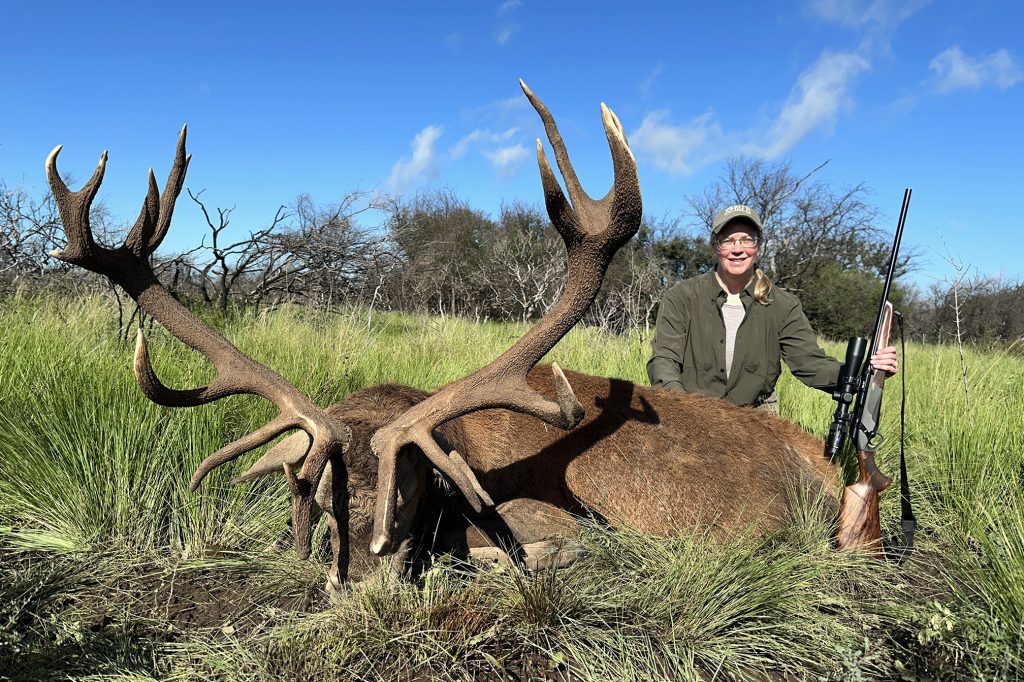
Once we had finished our photos, two of German’s assistant guides set to work on my stag, quartering it in minutes using a couple of the most gigantic knives I had ever seen. German suggested we head back to the lodge for lunch, but I was in no hurry to leave, fascinated as I was by watching these experts wield their traditional gaucho knives, which, I later learned, they used just as handily to trim a tree branch or slice a piece of steak.
Big red stags, among the world’s most magnificent antlered animals, are the first thing big-game hunters think of when they think of Argentina. Red deer were brought to Argentina’s La Pampa Province from Europe in 1906, and they found the brushy habitat to their liking. With good management, populations grew and thrived.
As my hosts explained it to me, for a red stag in central Argentina, la vida es buena—life is good. They have all the advantage of ideal habitat, plenty to eat, and a far milder year-round climate than they had in their native environs. As a result, Southern Hemisphere stags grow antlers of eye-popping dimensions.
But, as stunning as they are, stags are not the real reason Argentina is the most popular hunting destination in the world, attracting more than 20,000 visiting hunters every year—more than every country in Africa combined. That reason is the ubiquitous eared dove. The resident flocks, numbering in the tens of millions, are considered agricultural pests, consuming as much as 30 percent of the crop yield, and the local farmers encourage hunters to come and shoot as many doves as their shoulders can stand. Avid wingshooters come from all over the world to do exactly that.
While Cordoba is the most common destination for dove shooting, and the foothills of the Andes are the most famous region for stags, La Pampa Province is the place for the hunter who wants to do it all. Its easily accessible location in central Argentina makes it ideally suited to a combo hunt for birds and big game. That’s why I had shepherded both a rifle and a shotgun through Argentina’s complex importation process: I was here to experience the best of both hunting worlds.
From the moment I arrived at the GBH Safaris lodge and game preserve in La Pampa, about 100 miles north of the capital city of Santa Rosa, the terrain in the region, and in fact, the whole hunting vibe, reminded me of Africa. The landscape, consisting of broad openings of tall grass surrounded by large areas of thick brush and dotted with thorny, mesquite-like trees known as calden, is reminiscent of the Dark Continent, as are the fiery orange-red sunsets that paint the horizon every evening. And of course, there’s the familiar thrill of seeing the Southern Cross hanging in the night sky over a crackling campfire—a thrill that never gets old.
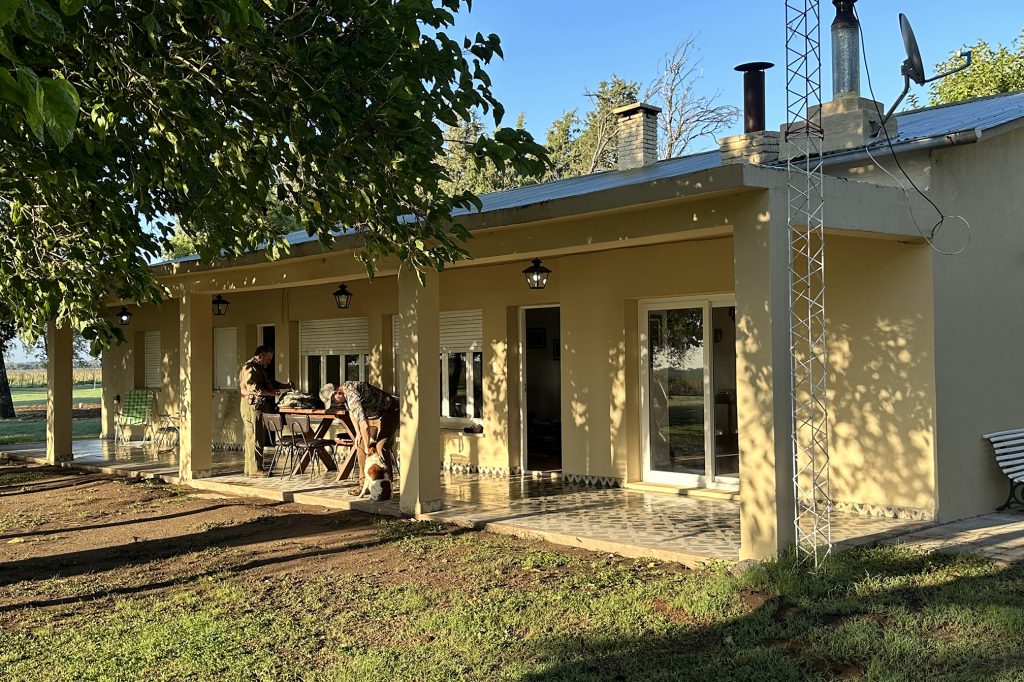
The Argentine culture, however, is rich and distinctive. Hunters enjoy a hearty midday asado, followed by a long afternoon siesta. Late-night dinners are accompanied by goblets of excellent local malbec. Seemingly every local is drinking mate out of a gourd with a straw. If you’re lucky, you’ll glimpse gauchos on horseback working cattle, many of them wearing traditional dress and riding effortlessly on sheepskin-lined saddles. And over it all soar seemingly endless flocks of the speedy and challenging game bird the locals call palomas.
I had awakened on my first morning in Argentina to a deafening cacophony of birds. As I would soon learn, the pampas are home to an astonishing array of feathered flying creatures, including noisy flocks of green parakeets, crested caracaras, eagles, flycatchers, and woodpeckers. The doves are in huge flocks nearly everywhere you look, lifting from the trees in shifting black clouds and rocketing over your head on whistling wings.
Because central Argentina’s balmy climate allows for year-round staggered planting and harvesting, doves breed prolifically and they rarely lack for a good meal. I had read about the incredible numbers of these birds, but it was still mind-boggling to stand in a field and watch them wing overhead by the thousands.
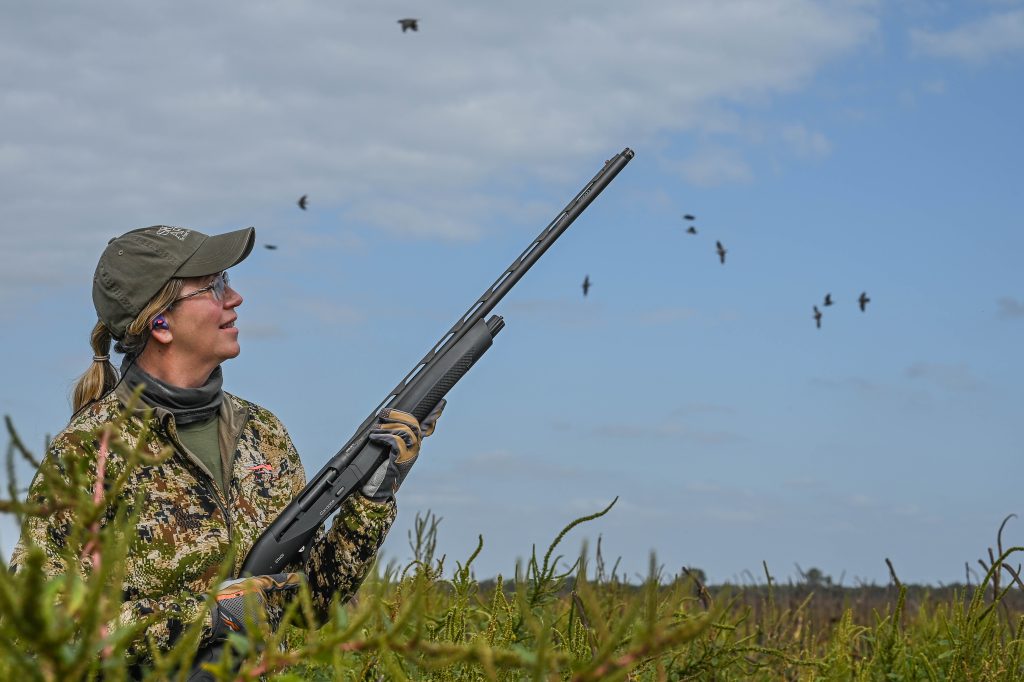
The way of life in Argentina involves late nights and a long afternoon siestas, so for me it took a bit of getting used to, but it works very well for hunting. On a typical day, we would have a morning dove shoot, a hearty lunch and a long break in the afternoon, then head back out for stags or blackbuck in the evening, followed by an after-dark sojourn for pigs or varmints. Dinner would be served as late as 11 p.m. or midnight, followed by a few hours of sleep and another enjoyable day in the field.
The lodge was surrounded by fields of standing corn and cut sunflowers, so we didn’t have to go far to find great dove shooting. Four or five shooters would typically spread out along a field edge or fence line and target birds as they flew across it. While we didn’t have individual “bird boys,” as many lodges do, German’s guides walked along the line periodically, keeping us well supplied with shells and drinks and anything else we needed.
The little palomas are blazing fast and wary. They say doves can fly 55 mph, and I don’t doubt it. I quickly learned not to bother with birds that had flown past me, as they would have already put on their afterburners. Instead I concentrated on incoming doves and crossing shots. As long as I was able to conceal myself behind a tall weed, I had the best luck on incomers, frequently dropping them on the toe of my own boot.
After we’d been in the field for a few hours, the guides would roll up in a truck to pick us up. They’d usually find me surrounded by a pile of doves and a much larger pile of empty shell casings, tired, slightly sunburned, and grinning.
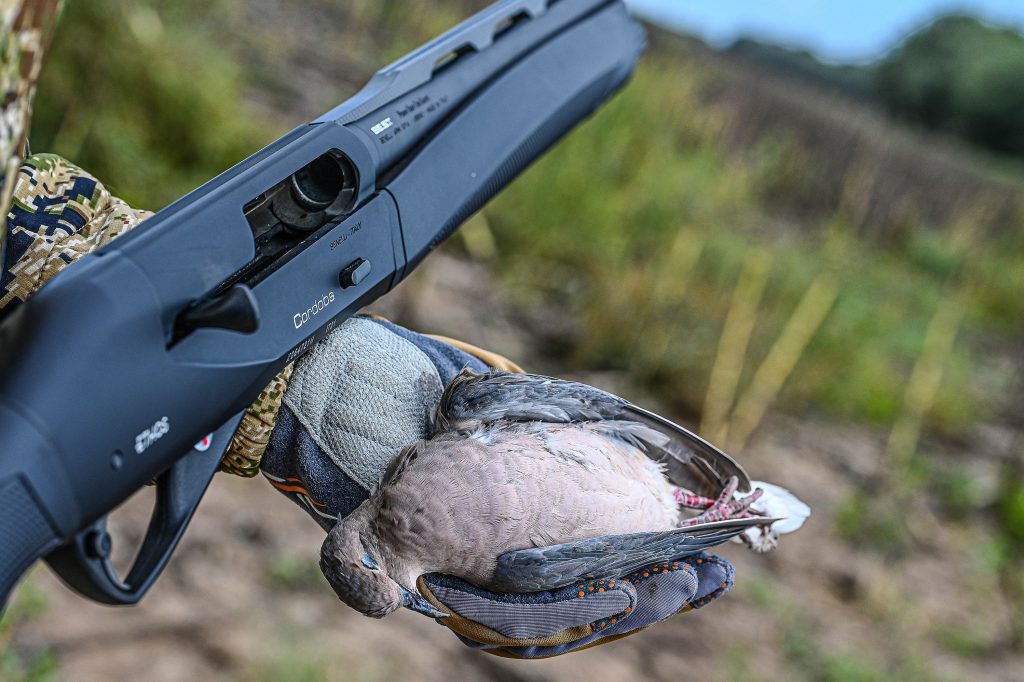
In addition to red stags, our big-game list included blackbuck and wild boars. The boars are largely nocturnal, and although I ventured out a couple of nights after dark, I never saw one, although I was treated to sightings of Patagonian hares, a silver fox, and a black-and-white rodent called a vizcacha.
I was, however, hoping to close the deal on a blackbuck, another introduced species (this one originally from India) that has thrived in central Argentina alongside the red deer. Significantly smaller than our pronghorn, these animals have tall, twisting horns and dark, beautifully marked coats from which they get their name. I spent several enjoyable hours spotting and stalking these lovely, elusive little antelope, but each time they gave me the slip in the thick bush.
Late one afternoon I was sitting in an elevated blind with a guide named Matteo, who had taken some time out of working his wizardry on the lodge’s outdoor clay oven and barbecue grill to help me look for a blackbuck, which he called antilope. I know very little Spanish, and good-natured Matteo didn’t speak a word of English, so we had plenty of laughs as we attempted, with varying degrees of success, to communicate.
As evening approached, a bachelor group of blackbuck rams materialized out of the brush about 500 yards away. I studied them through my binocular, then turned to Matteo, who was doing the same. He looked at me with a grin and said, “Grande!”
That was good to know, but there were a dozen rams in the herd. They all looked grande to me, but I was certainly no expert. As the herd worked its way toward us, feeding slowly, I studied the rams but could tell little difference between them.
As they began to move into range of our position, I searched every corner of my brain for my limited Spanish vocabulary. Finally I came up with, “Todos?” (All?)
Matteo nodded enthusiastically. “Si! Todos. Grande.”
Well, that made it easy. About 150 yards from the blind, the herd stopped and began milling nervously, and I figured it was now or never. A nice-looking ram was standing clear of the others, and I rested the rifle and carefully squeezed off a shot. Hit through both lungs, he bolted forty yards and dropped stone-dead as the other rams scattered into the trees.
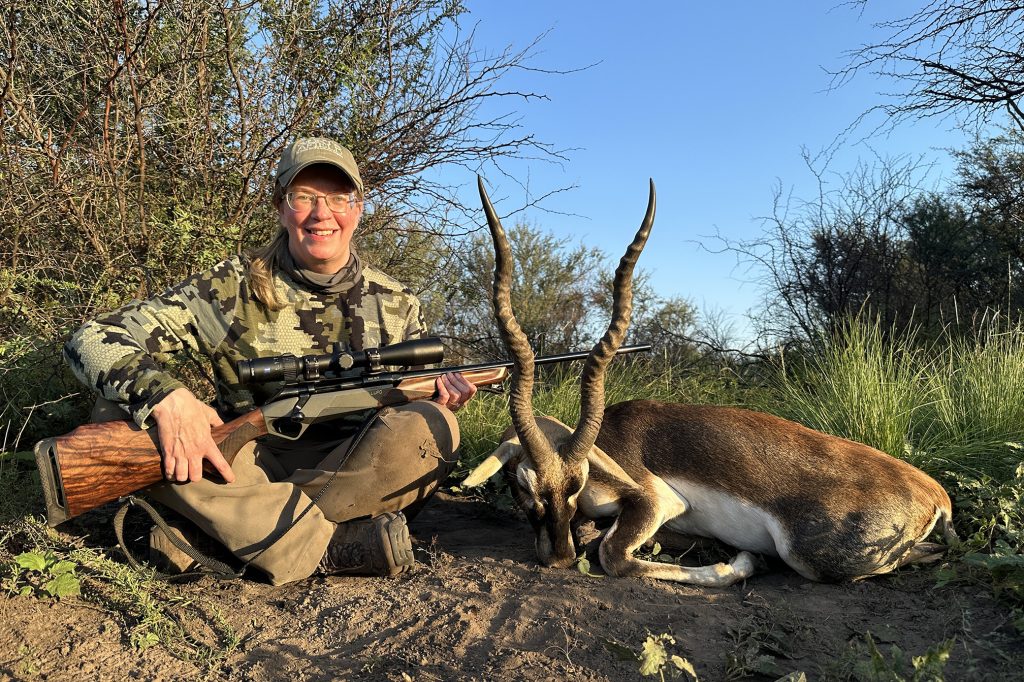
The blackbuck turned out to be a very fine, mature ram. We walked up to him as a stunning sunset bathed the pampas in an orange glow. With Matteo’s help, I photographed the beautiful animal in the evening light as a flock of doves fluttered into a waterhole nearby. For a hunter in Argentina, la vida es buena.
For more information on this hunt, contact German Brandazza, GBH Safaris: gbhsafaris.com.ar.
The Lupo and the Cordoba
Argentina is not an easy place in which to import your own firearms, so if you’re going to go through the hassle of bringing your own guns for a bird-and-big-game combo hunt, they might as well be the best possible tools for the job.
I can’t imagine a more ideal rifle/shotgun combo than the one I used on this hunt: Benelli’s Lupo BE.S.T. in .300 Winchester Magnum and the Ethos Cordoba BE.S.T. shotgun in 20-gauge.
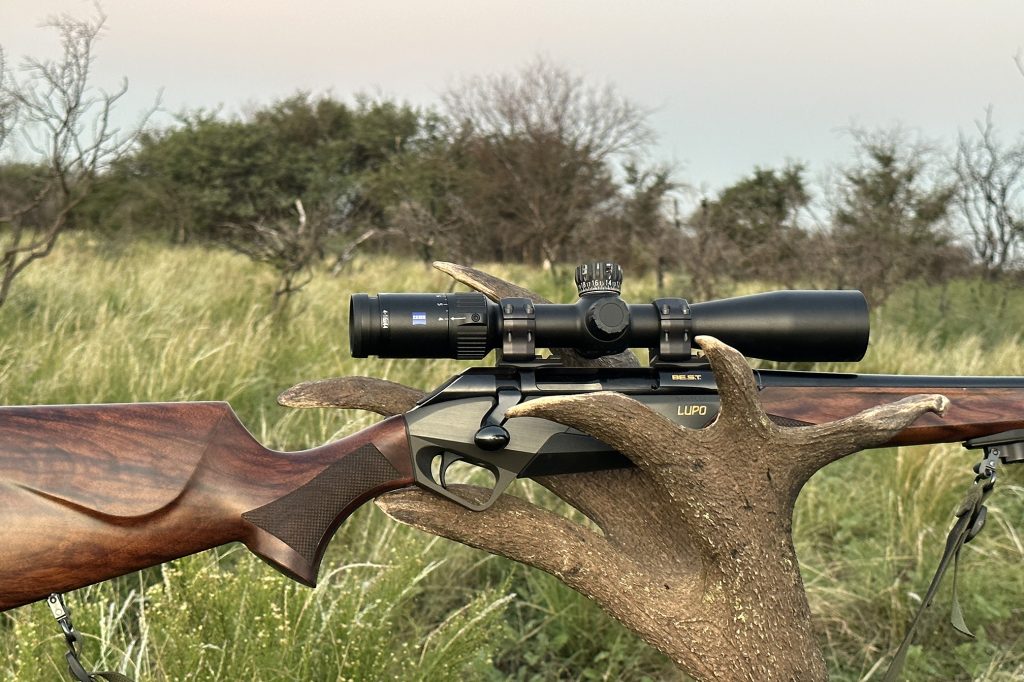
The Lupo rifle comes in several configurations, and every one of these guns I’ve tested has been extremely accurate and consistent. The Lupo BE.S.T. rifles are particularly special, featuring premium AA-grade walnut stocks and Benelli Surface Treatment (BE.S.T.) finish, guaranteed against rust and corrosion for 25 years. Beautiful and bombproof is a pretty irresistible combination in a rifle. I fed the Lupo Hornady’s Precision Hunter ammo with 178-grain ELD-X bullets, which performed perfectly on both the stag and the blackbuck.
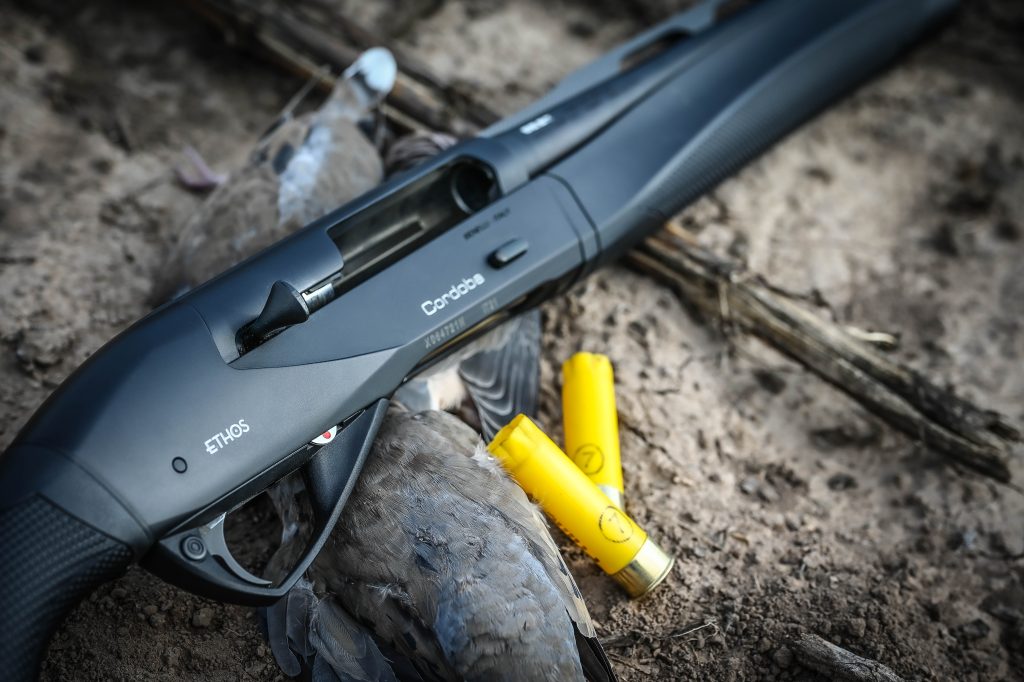
If you’re going to shoot boxes and boxes of shells at doves, you need a soft-shooting but extremely durable and dependable gun that fits you well. The sleek Ethos Cordoba BE.S.T. shotgun fits the bill. Ported barrels and the ComforTech recoil-reduction system helped my shoulder withstand the rigors of repeated shots, and the inertia-driven semiauto proved flawlessly reliable. I also liked the beveled loading port, large bolt handle, and enhanced trigger guard, which made it easy to load and shoot while wearing my lightweight shooting gloves. And since it also has the BE.S.T. finish, this shotgun boasts excellent rust and corrosion protection.—D.R.

